11 Standout Ideas for Garden Paving
http://decor-ideas.org 09/03/2015 01:13 Decor Ideas
When creating your garden, it’s easy to simply decide on a single paving product and lay it everywhere — just as many of your neighbors may have done. But the stonework in your garden doesn’t have to be the same as the rest of the street’s, because even the smallest detail can lift quite ordinary paving into another league. Using some great details and simple twists, you can add character and individuality to your garden. Let these outside spaces spark some creative ideas of your own.
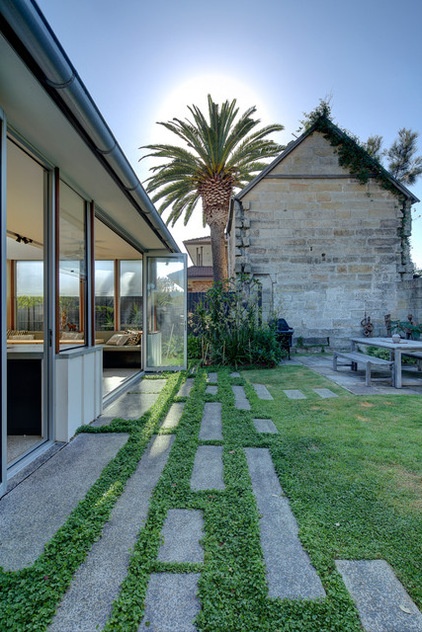
1. Repurpose some street stones. There’s beauty in old stone, and you can pick up old granite curbstones at stone yards. When curbstones are used as in the yard seen here, they can help create a really great aesthetic; the simple lines and stones of differing lengths lead from the house to a seating area.
Lay curbstones across the garden to make it feel wider; lay them lengthways to make it feel longer.
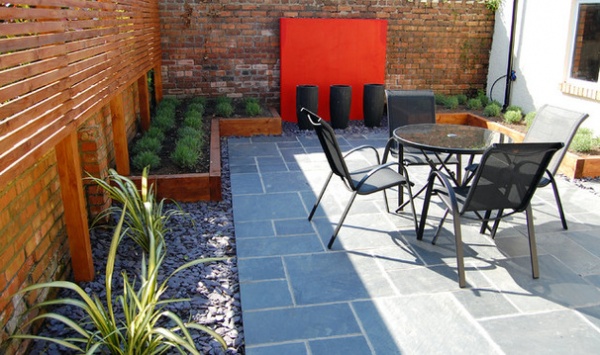
2. Mix dull tones with color. The slate-gray tones of many surfaces can be miserable in a small garden under a cloudy sky. In this garden we can see how the beautiful gray limestone paving is surrounded by a burst of bright color that makes the paving even more beautiful.
In itself the paving is stylish, and the pale gray cement used as mortar sets off each individual slab. Eventually the colors will fade a bit, but the contrast between the walls and the new plants will continue to give this space a stylish spin.
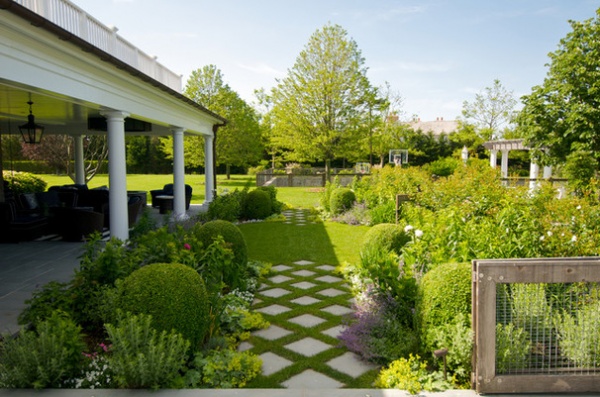
3. Play with pattern. This garden takes the steppingstone theme one step further. The pattern of simple square pavers laid on the lawn pulls you through a border and out to a circular lawn, and then farther out to a larger lawn.
Adding pavers set on a directional 45-degree angle is a simple but effective way to create motion through a garden — and the idea is easy to copy. To mow the lawn, just push your lawnmower over the entire top.
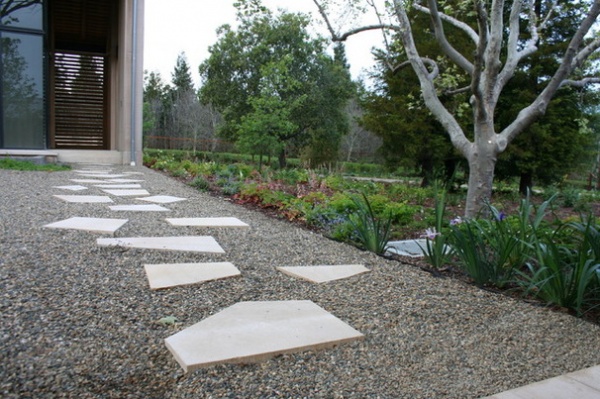
4. Add modern steppingstones. These large pieces of “broken” concrete create a great random-looking path across a gravel surface. Children would love jumping from one to another, while the two surface materials work together to create a path to the front door.
Steal the idea with gravel and old flagstones broken into uneven slabs to create your own contemporary take on a steppingstone path.
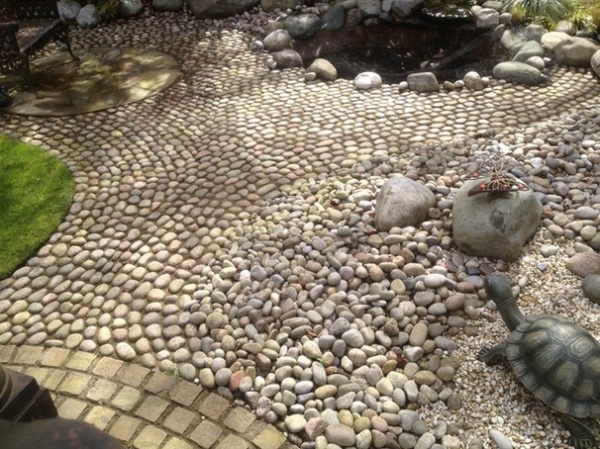
5. Go freestyle. In this garden, cobblestones, pavers and gravel have been brought together to create a flowing path that leads you through the space. You can take this idea for the smallest spaces and visually pull visitors in different directions. For design ideas, think wave patterns, swirls and beach-like funnels to create freestyle pathways with unique patterns.

6. Go traditional. You can always tell stylish paving by the pattern in which it’s been laid, and this elegant path up to a big house displays the garden’s style. But you don’t need a grand country estate to steal this style: Get the look by laying pavers in a simple, traditional pattern. Laying the pavers in regular rows is easy, because most of them arrive in regular widths, so you waste very little in cutting them to size.
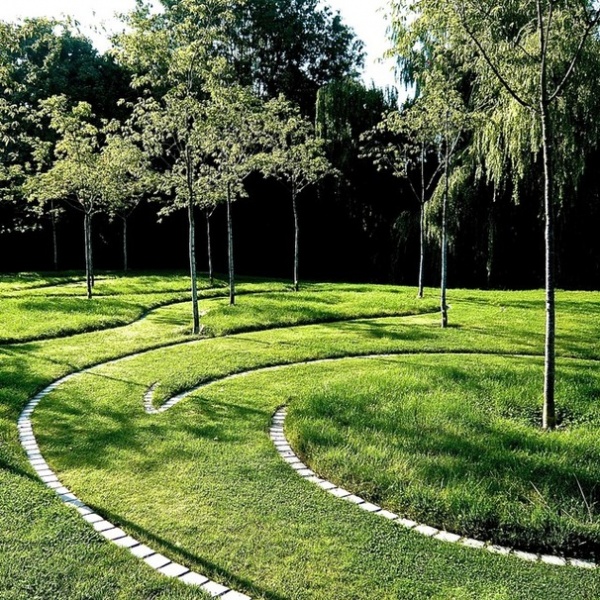
7. Get setts. There’s a trend for land-forming these days, whether it’s done by forming large mounds and hills, or just playing with how the grass is cut.
In this garden, the designer has taken the idea one step further by delineating the trees and meadow areas with a smart mown path edging made from small sett stones, or Belgian block stones. This cuts down on the need to figure out where the path is and where the plants are.
If your garden design is similar, you could also plant the spaces beneath the trees with spring bulbs and wildflowers, knowing you won’t step on them as they’re growing, since the setts will tell you where to walk.

8. Use the same stone in different ways. A simple way to tie all the hard elements of your garden together is to use the same material in different ways.
In this Mediterranean-style garden, we used sandstone paving from a local quarry and also sourced the stone for the walls from the same place. The wall stones were taken from different parts of the quarry, so the tones vary a little, but ultimately the material ties the garden together.
If you use this idea, you could also try mixing regular square pavers with a panel of crazy paving for a little contrast.
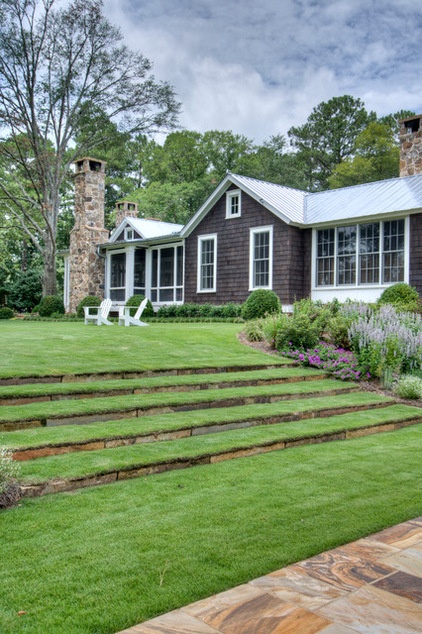
9. Step up (or down). Lots of gardens have level changes, which can be really expensive or difficult to deal with. In this garden, the paving has been reduced by the use of simple grass steps with stone retainers. You could easily do this with reclaimed materials, backfilling with soil and turfing the surfaces.
It’s great where large steps are needed but is equally at home on narrower stairs. Just make the steps deep enough to get a lawn mower in for ease of maintenance.
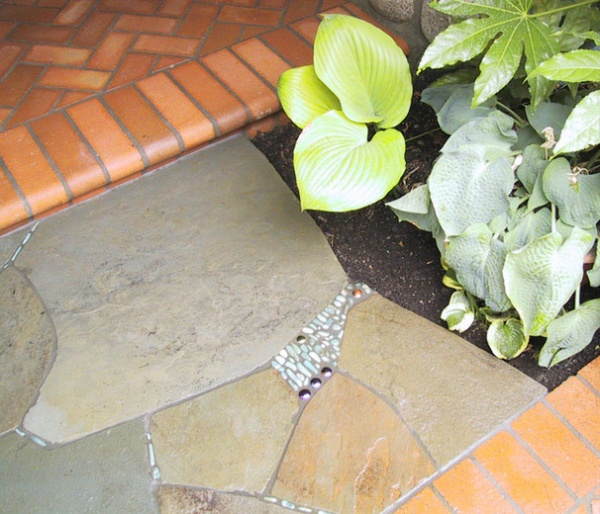
10. Work in special details. Achieving a large mosaic-paved area can be daunting and is often costly. I love this path that uses just a small area of mosaic infill amid crazy paving. Even better, it’s not just pebbles — some jewel-like stones or marbles have been added to catch the glint of the sun and create a small detail that makes this paving unique.
This design is easily done, and with found objects that are he right size, you could even take out one or two pavers in an existing patio and copy this idea in a few hours.
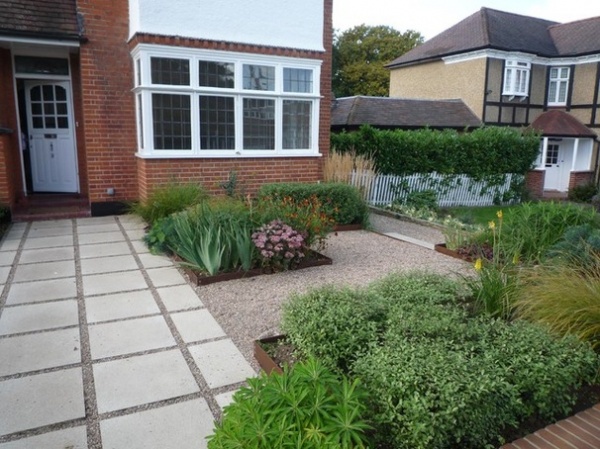
11. Be stylish on a budget. Paving is one of the most expensive materials in a garden, but it doesn’t mean you should miss out on a stylish solution. In this garden, very simple and inexpensive concrete pavers have been combined with gravel in a simple pattern to create a standout path.
The gravel has been taken into the rest of the front garden, where fewer people will walk but where it gives access to all the planted beds. The design is simple, effective and great for drainage.
More
See more patio ideas on Houzz
Read more about paths and paving
Related Articles Recommended












